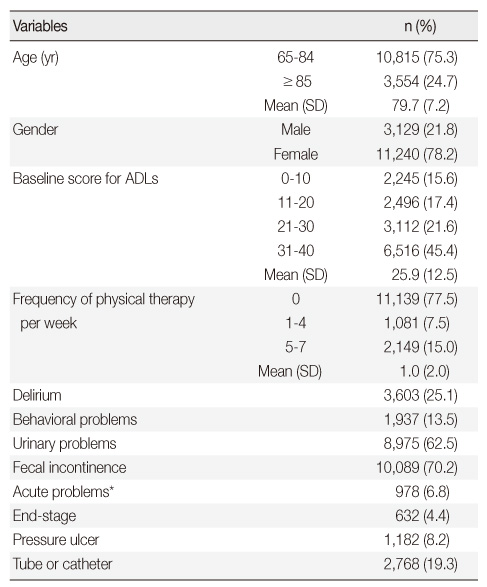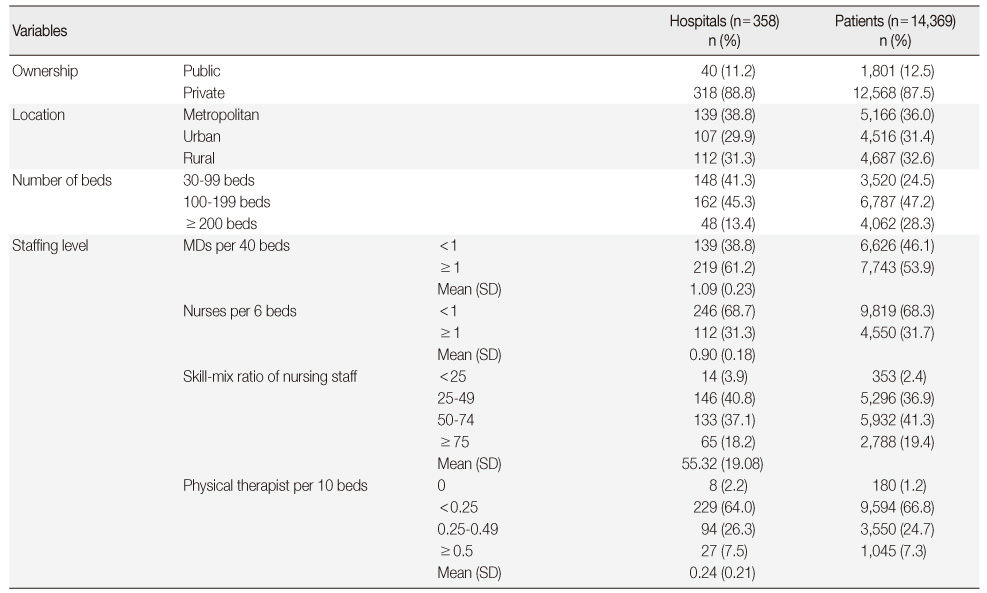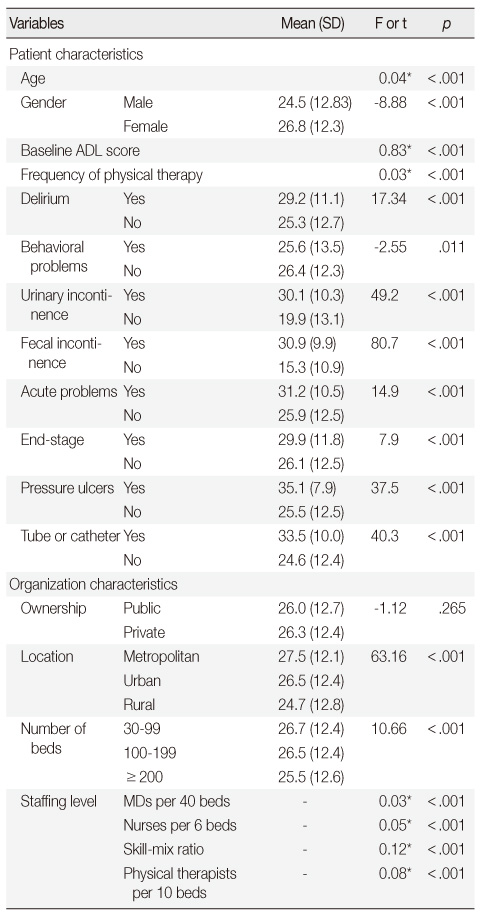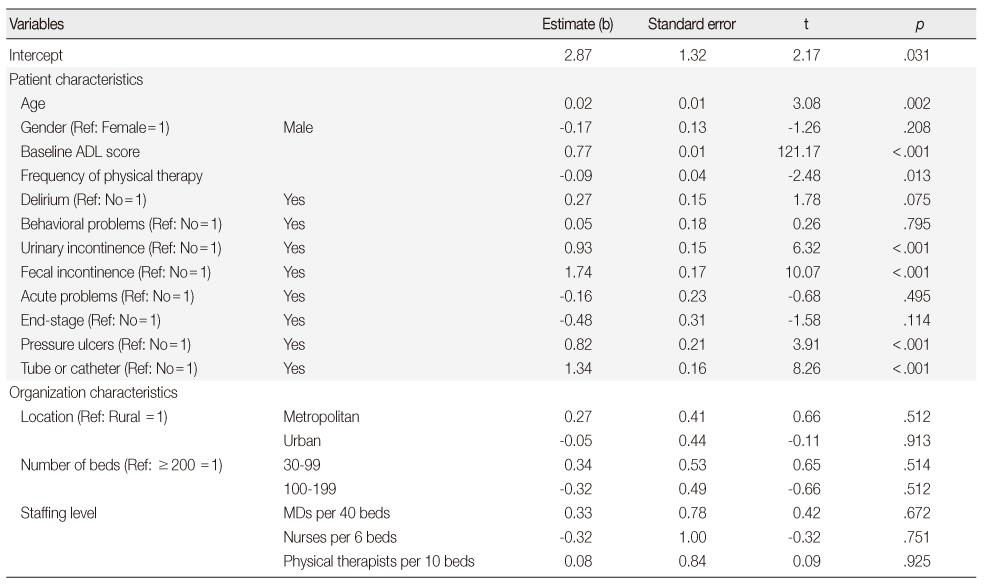Articles
- Page Path
- HOME > J Korean Acad Nurs > Volume 41(6); 2011 > Article
-
Original Article
- Factors Impacting the Physical Function of Older Adults in Korean Long-Term Care Hospitals
- Ji-Yun Lee, Eun-Young Kim, Eunhee Cho
-
Journal of Korean Academy of Nursing 2011;41(6):780-787.
DOI: https://doi.org/10.4040/jkan.2011.41.6.780
Published online: December 31, 2011
1Associate Professor, Department of Nursing, Kangwon National University, Chuncheon, Korea.
2Associate Professor, Department of Nursing, Dong-A University, Busan, Korea.
3Assistant Professor, Nursing Policy Research Institute, College of Nursing, Yonsei University, Seoul, Korea.
- Address reprint requests to: Cho, Eunhee. Yonsei University College of Nursing, 134 Sinchon-dong, Seodaemun-gu, Seoul 120-752, Korea. Tel: +82-2-2228-3251, Fax: +82-2-392-5440, ehcho@yuhs.ac
© 2011 Korean Society of Nursing Science
- 1,044 Views
- 4 Download
- 11 Crossref
Abstract
-
Purpose
- This study was conducted to examine activities of daily living (ADL) of older adults admitted to Korean long-term care hospitals (LTCHs), and to explore the patient and organizational factors that have an impact on the ADL of this population.
-
Methods
- A secondary analysis of the Korean minimum data set (K-MDS) of patients (N=14,369) and of the profiles of LTCHs (N=358) from the Health Insurance Review and Assessment Service was done between January and July 2008. The outcome variable was ADL score 6 months after baseline assessment. Multi-level linear regression was employed to explore the patient and organizational factors that affected ADL scores.
-
Results
- Of the patients, 45.4% had a baseline ADL score of between 31 and 40, with a score of 40 indicating that the patient was entirely dependent for all items. None of the organizational characteristics were significantly associated with effects on the ADLs of older adults who had been in a LTHC for at least 6 months. However, patient characteristics, such as age, baseline ADL, frequency of physical therapy, urinary incontinence, fecal incontinence, pressure ulcers, and having a tube or catheter, were significantly associated with ADL 6 months after baseline.
-
Conclusion
- In order to maintain and improve the ADL of older adults in LTCHs, we should develop strategies to prevent urinary and fecal incontinence, pressure ulcers, unnecessary tubes or catheters, providing adequate physical therapy. Additional studies should include more detailed information regarding nursing staff, including RN hours for direct care, education level and turnover.
INTRODUCTION
METHODS
1) Korean minimum data set (K-MDS)
2) Hospital profile
1) Outcome variable
2) Predicting variables
RESULTS
DISCUSSION
CONCLUSIONS
- 1. Ang YH, Au SYL, Yap LKP, Ee CH. Functional decline of the elderly in a nursing home. Singapore Medical Journal. 2006;47:219–224.PubMed
- 2. Barberger-Gateau P, Fabrigoule C, Amieva H, Helmer C, Dartigues JF. The disablement process: A conceptual framework for dementia-associated disability. Dementia and Geriatric Cognitive Disorders. 2002;13(2):60–66. doi: 10.1159/000048635.ArticlePubMedPDF
- 3. Bostick JE, Rantz MJ, Flesner MK, Riggs CJ. Systematic review of studies of staffing and quality in nursing homes. Journal of the American Medical Directors Association. 2006;7(6):366–376. doi: 10.1016/j.jamda.2006.01.024.ArticlePubMed
- 4. Buttar A, Blaum C, Fries B. Clinical characteristics and six-month outcomes of nursing home residents with low activities of daily living dependency. The Journals of Gerontology. 2001;56(5):M292–M297.ArticlePubMed
- 5. Centers for Medicare and Medicaid Services. Report to congress: Appropriateness of minimum nurse staffing ratios in nursing homes. Phase II Final report. 2001;Baltimore, MD, Author.
- 6. Cho SH, Hwang JH, Kim JY. Nurse staffing and patient mortality in intensive care units. Nursing Research. 2008;57:322–330. doi: 10.1097/01.NNR.0000313498.17777.71.ArticlePubMed
- 7. Cohen J. Statistical power analysis for the behavioral science. 1998;2nd ed. New Jersey, Lawrence Erlbaum Associates.
- 8. Collier E, Harrington C. Staffing characteristics, turnover rates, and quality of resident care in nursing facilities. Research in Gerontological Nursing. 2008;1:157–170. doi: 10.3928/00220124-20091301-03.ArticlePubMed
- 9. Harrington C, Woolhandler S, Mullan J, Carrillo H, Himmelstein DU. Does investor ownership of nursing homes compromise the quality of care? American Journal of Public Health. 2001;91:1452–1455.ArticlePubMedPMC
- 10. Hong SP, Yi JJ, Yi SW. A factors related to activities of daily living (ADL) among patients in geriatric hospitals. Journal of Korean Academy of Occupational Therapy. 2007;15(2):79–89.
- 11. Horn SD, Buerhaus P, Bergstrom N, Smout RJ. RN staffing time and outcomes of long-stay nursing home residents: Pressure ulcers and other adverse outcomes are less likely as RNs spend more time on direct patient care. American Journal of Nursing. 2005;105(11):58–70. quiz 71.
- 12. Kim EK, Chang HS, Oh JH, Bae SK. Reserch on the actual condition and operation plan of long-term care hospitals. 2003;Seoul, Korean Health Industry Development Institute.
- 13. Kim SM, Park JY, Han CH. Influential factors on rehabilitation exercise practice in elderly limited activities of daily-living: An analysis based on the theory of planned behavior. Journal of the Korea Contents Association. 2010;10:271–281.
- 14. Korea Development Institute. Challenges of the long-term care insurance. Symposium conducted at the meeting of the Korea Development Institute. 2010;Seoul, Author.
- 15. Medical treatment law. Korea Ministry of Goverment Legislation. 2010;Retrieved December 1, 2010. from http://www.law.go.kr/main.htm.
- 16. Estimated population by age. Korea National Statistical Office. 2011;Retrieved July 1, 2011. from http://kosis.kr/themes/themes_02List.jsp#jsClick.
- 17. Lee CI, Park DM, Park RJ. The effect of muscle enforcement exercise program on posture balance of the institution old. Journal of Dae-gu University. 2005;1:539–565.
- 18. Lee J, Rantz MJ. Admission factors influencing activities of daily living in nursing home residents admitted from acute care hospitals. Journal of Korean Gerontological Nursing. 2008;10(1):68–76.
- 19. Lee JY, Yoon JY, Jang SR. A study of validity and reliability of a patient assessment instrument for long-term care hospitals. Journal of Korean Gerontological Nursing. 2008;10(1):7–19.
- 20. Lee JY, Yoon JY, Kim AR, Kim CM. Development of quality management system and indicators of long term care hospitals. 2008;Seoul, Health Insurance Review and Assessment Service.
- 21. Lee SH. Multi-level analysis of factors related to quality of services in long-term care hospitals. Journal of Korean Academy of Nursing. 2009;39:409–421. doi: 10.4040/jkan.2009.39.3.409.ArticlePubMed
- 22. Lee SY, Park EK, Yoon JY, Song SH. The current status of long-term care hospital. 2007;Seoul, Health Insurance Review & Assessment Service.
- 23. McCusker J, Cole M, Dendukuri N, Belzile E, Primeau F. Delirium in older medical inpatients and subsequent cognitive and functional status: A prospective study. Canadian Medical Association Journal. 2001;165:575–583.PubMedPMC
- 24. Moineddin R, Matheson FI, Glazier RH. A simulation study of sample size for multilevel logistic regression models. BMC Medical Research Methodology. 2007;7:34. doi: 10.1186/1471-2288-7-34.PubMedPMC
- 25. Morris JN, Murphy K, Nonemaker S. RAI-FC assessment manual version 2.0. 2004;Baltimore, Center for Medicare and Medicaid Services.
- 26. Peres K, Verret C, Alioum A, Barberger-Gateau P. The disablement process: Factors associated with progression of disability and recovery in French elderly people. Disability and Rehabilitation. 2005;27(5):263–276. doi: 10.1080/09638280400006515.ArticlePubMed
- 27. Phillips CD, Shen R, Chen M, Sherman M. Evaluating nursing home performance indicators: An illustration exploring the impact of facilities on ADL change. The Gerontologist. 2007;47:683–689.ArticlePubMed
- 28. Rantz MJ, Hicks L, Grando V, Petroski GF, Madsen RW, Mehr DR, et al. Nursing home quality, cost, staffing, and staff mix. Gerontologist. 2004;44(1):24–38. doi: 10.1093/geront/44.1.24.ArticlePubMed
- 29. Spilsbury K, Hewitt C, Stirk L, Bowman C. The relationship between nurse staffing and quality of care in nursing homes: A systematic review. International Journal of Nursing Studies. 2011;48:732–750. doi: 10.1016/j.ijnurstu.2011.02.014.ArticlePubMed
- 30. Wu AW, Yasui Y, Alzola C, Galanos AN, Tsevat J, Phillips RS, et al. Predicting functional status outcomes in hospitalized patients aged 80 years and older. Journal of the American Geriatrics Society. 2000;48:5 Suppl. S6–S15.PubMed
REFERENCES
Figure & Data
REFERENCES
Citations

- Just visiting: A qualitative study of Australian allied health professionals' experiences working in residential aged care facilities during the COVID‐19 pandemic
Isabelle Meulenbroeks, Karla Seaman, Magdalena Z. Raban, Nasir Wabe, Johanna Westbrook
Australasian Journal on Ageing.2023; 42(4): 690. CrossRef - Allied health in residential aged care: Using routinely collected data to improve funding opportunities
Isabelle Meulenbroeks, Karla Seaman, Magdalena Z. Raban, Johanna Westbrook
Australasian Journal on Ageing.2023; 42(1): 221. CrossRef - Therapy-based allied health delivery in residential aged care, trends, factors, and outcomes: a systematic review
Isabelle Meulenbroeks, Magdalena Z. Raban, Karla Seaman, Johanna Westbrook
BMC Geriatrics.2022;[Epub] CrossRef - Effects of registered nurse staffing on quality of care and resident outcomes in nursing homes
Eunhee Cho, In Sook Kim, Tae Wha Lee, Gwang Suk Kim, Hyeonkyeong Lee, Deulle Min
Geriatric Nursing.2020; 41(6): 685. CrossRef - Nationwide survey of continence status among older adult residents living in long‐term care facilities in Japan: The prevalence and associated risk factors of incontinence and effect of comprehensive care on continence status
Motofumi Suzuki, Jiro Okochi, Katsuya Iijima, Taro Murata, Haruki Kume
Geriatrics & Gerontology International.2020; 20(4): 285. CrossRef - Ultrasound‐assisted prompted voiding care for managing urinary incontinence in nursing homes: A randomized clinical trial
Motofumi Suzuki, Hideyo Miyazaki, Jun Kamei, Mikako Yoshida, Tamami Taniguchi, Kaoru Nishimura, Yasuhiko Igawa, Hiromi Sanada, Yukio Homma
Neurourology and Urodynamics.2019; 38(2): 757. CrossRef - Longitudinal associations of nursing staff turnover with patient outcomes in long-term care hospitals in Korea
Yoonseo Kim, Kihye Han
Journal of Nursing Management.2018; 26(5): 518. CrossRef - Ultrasound‐assisted prompted voiding for management of urinary incontinence of nursing home residents: Efficacy and feasibility
Motofumi Suzuki, Yasuhiro Iguchi, Yasuhiko Igawa, Mikako Yoshida, Hiromi Sanada, Hideyo Miyazaki, Yukio Homma
International Journal of Urology.2016; 23(9): 786. CrossRef - Impact of Nurse Staffing Level and Oral Care on Hospital Acquired Pneumonia in Long-term Care Hospitals
Jung Mi Chae, Hyunjong Song, Gunseog Kang, Ji Yun Lee
Journal of Korean Academy of Nursing Administration.2015; 21(2): 174. CrossRef - Nursing outcomes of inpatient on level of nursing staffing in long term care hospitals
Eun Hee Kim, Eunjoo Lee
Journal of the Korean Data and Information Science Society.2015; 26(3): 715. CrossRef - Impact of Nurse, Nurses' Aid Staffing and Turnover Rate on Inpatient Health Outcomes in Long Term Care Hospitals
Yunmi Kim, Ji Yun Lee, Hyuncheol Kang
Journal of Korean Academy of Nursing.2014; 44(1): 21. CrossRef
Patient Characteristics at Baseline (N=14,369)
*Acute health problems: Fever, dehydration, vomiting, or bleeding.
ADL=Activities of daily living.
Organization Characteristics
MD=Medical doctor.
ADLs Score after 6 Months by Patient and Organizational Characteristics
*Pearson's r.
ADL=Activities of daily living; MD=Medical doctor.
Association of Patient and Organizational Characteristics with ADLs after Six Months
ADL=Activities of daily living; MD=Medical doctor.
*Acute health problems: Fever, dehydration, vomiting, or bleeding. ADL=Activities of daily living.
MD=Medical doctor.
*Pearson's r. ADL=Activities of daily living; MD=Medical doctor.
ADL=Activities of daily living; MD=Medical doctor.
 KSNS
KSNS
 E-SUBMISSION
E-SUBMISSION




 Cite
Cite

